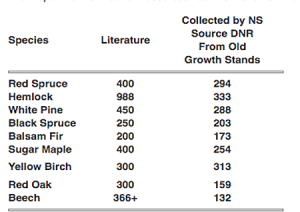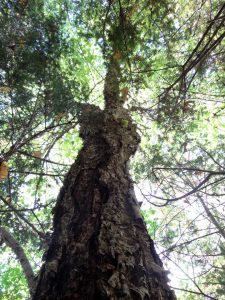A selection to help us open our eyes
‘Workin on it
 NS Woodlot Home Study Guide Module 4: Woodlots and Wildlife/Lesson Three – Habitats and Species of Special Conservation Concern
NS Woodlot Home Study Guide Module 4: Woodlots and Wildlife/Lesson Three – Habitats and Species of Special Conservation Concern
‘needs to be brought up-to-date, but otherwise a helpful intro. to Old Growth and other special habitats.
Old Growth Forest Survey of Eastern Niagara Peninsula Phase 2/ Final Report
By Bruce Kershner Project of Bert Miller Nature Club. Final Report to Trillium Foundation, October 2004, Native Tree Society Special Publication Series: Report #13. Very relevant to NS right now, e.g., provides “Visual Categories of Old Growth”, “Old Growth Bark (“Antique Bark”)”, “Indicators that a Site May Not Be Old Growth”, “Pit and Mound Shapes on the Forest Floor”
 External Characteristics of Old Trees in the Eastern Deciduous Forest
External Characteristics of Old Trees in the Eastern Deciduous Forest
Neil Pederson Natural Areas Journal 30(4), (1 Oct 2010).
“Six common external characteristics of old angiosperm trees include: (1) smooth or “balding” bark; (2) low stem taper; (3) high stem sinuosity; (4) crowns comprised of few, large-diameter, twisting limbs; (5) low crown volume; and (6) a low ratio of leaf area to trunk volume. ”
New Estimates of Massachusetts Old-growth Forests: Useful Data for Regional Conservation and Forest Reserve Planning
Anthony W. D’Amato et al. 2006 NORTHEASTERN NATURALIST 13(4):495–506
“We estimate that the total area of old-growth in the state is 453 ha, in 33
stands that range from 1.2 to 80.9 ha in size…Several criteria were applied in the field to help identify old-growth forests: 1) the absence of any evidence of past land-use (e.g., cut stumps, stone walls or structures, numerous multiple-stemmed trees); 2) the presence of at least 5 old trees (> 225 years old; indicating establishment prior to European settlement in these locations and exceeding 50% of the maximum longevity for species commonly encountered ) per hectare in the forest overstory as determined through the collection of increment core samples; and 3) the existence of forest structural characteristics that are often indicative of old-growth condition, such as pit and mounds, large snags, gnarled tree crowns, and the accumulation of large volumes of coarse woody debris.”
FOREST MANAGEMENT GUIDELINES TO PROTECT NATIVE BIODIVERSITY IN THEGREATER FUNDY ECOSYSTEM Second Edition
Greater Fundy Ecosystem Research Group Editors: Matthew Betts and Graham Forbes, 127 pages. Comprehensive. “The goal of this document is to provide a vision for forest management based on ecological processes.” Chapter 2: Amount of Mature Forest at the Landscape Scale by MG Betts et al. is particularly pertinent to “What is Old Growth?”
Old-Growth Forests: Back to the Future?
Post by Joe Rankin on Forest for Maine’s Future, Jan 29, 2019. An informative review of “Ecology and Recovery of Eastern Old-Growth Forests” published in 2018 by Island Press, edited by Andrew M. Barton, a professor of ecology at the University of Maine at Farmington, and William S. Keeton, a professor of forest ecology and forestry at the University of Vermont. Thx to BW for this one
If an Old Growth stand in Nova Scotia blows down, is it still Old Growth?
Post, Feb 4, 2019. “My answer, Yes, if the blowdown is not removed (e.g. as a salvage harvest)”
Annapolis County residents want ‘Old Growth’ Corbett Lake Crown forest left alone
Lawrence Powell in Annapolis Co. Spectator, Apr 30, 2019. “Biologist Bob Bancroft toured Crown forest at Corbett Lake April 28 and described it as intact and unique. He said a fraction of one per cent of forests in Nova Scotia are as complete with species and ground cover as the woods south of Bridgetown on the Neaves Road”
Regeneration responses to management for old-growth characteristics in northern hardwood-conifer forests
Gottesman, Aviva Joy,(2017). Graduate College Dissertations and Theses.
https://scholarworks.uvm.edu/graddis/681
How restoring old-growth forest in Washington state could help fight climate change
The Seattle Times, Sep. 23, 2019 Several models for restoration are illustrated.
Description of an old-growth red spruce stand in Nova Scotia
by Szalamin, G.L
Mimeo (Canada. Dept. of Forestry), 1965
Book:
Available, CAN FO 22-5 65-M-5, NRCan Sault Ste. Marie – Reports
DECAY OF YELLOW BIRCH IN NOVA SCOTIA
M.A. Stillwell, Forest Chrinicle, march 1955
A study of the amount and types of decay in yellow birch, Betala Iutea
Michx. f., in Nova Scotia was undertaken in I951 and I952 in order to supply
those concerned with information necessary for proper forest management of
even-aged stands. A total of 374 trees was examined of which 35% contained
some measure of decay. Volume of decay increased with increasing age.
Approximately 50% of the trees contained decay at I20 to I30 years of age
and 100% at 230 years of age. The loss in merchantable volume increased from
a negligible amount at 60 years to about 10% at 240 years. No attempt was made to
predict a rotational cut based on diameter. A pathological rotation age of I70 years is suggested for yellow birch in Nova Scotia. Ten wood-destroying
fungi were found associated with rot in living trees, five in the butt and fiue in
the trunk. Poria cocos (Schw.) Wulf. caused the most frequent butt rot and
Fomes igniarius (L. ex Fr.) Gill. the most common trunk rot.
Ecology and Recovery of Eastern Old-Growth Forests
Andrew M. Barton and William S. Keeton 2018 island Press
“The landscapes of North America, including eastern forests, have been shaped by humans for millennia, through fire, agriculture, hunting, and other means. But the arrival of Europeans on America’s eastern shores several centuries ago ushered in the rapid conversion of forests and woodlands to other land uses. By the twentieth century, it appeared that old-growth forests in the eastern United States were gone, replaced by cities, farms, transportation networks, and second-growth forests. Since that time, however, numerous remnants of eastern old growth have been discovered, meticulously mapped, and studied. Many of these ancient stands retain surprisingly robust complexity and vigor, and forest ecologists are eager to develop strategies for their restoration and for nurturing additional stands of old growth that will foster biological diversity, reduce impacts of climate change, and serve as benchmarks for how natural systems operate.
Forest ecologists William Keeton and Andrew Barton bring together a volume that breaks new ground in our understanding of ecological systems and their importance for forest resilience in an age of rapid environmental change. This edited volume covers a broad geographic canvas, from eastern Canada and the Upper Great Lakes states to the deep South. It looks at a wide diversity of ecosystems, including spruce-fir, northern deciduous, southern Appalachian deciduous, southern swamp hardwoods, and longleaf pine. Chapters authored by leading old-growth experts examine topics of contemporary forest ecology including forest structure and dynamics, below-ground soil processes, biological diversity, differences between historical and modern forests, carbon and climate change mitigation, management of old growth, and more.
This thoughtful treatise broadly communicates important new discoveries to scientists, land managers, and students and breathes fresh life into the hope for sensible, effective management of old-growth stands in eastern forests.
Evaluating Old Growth Forest at Sixth and Silver Lakes, Nova Scotia
By Sarah Hart and Colin P. Laroque Mount Allison Dendrochronology Lab Report 2006-25, 12 pages “Abstract In Nova Scotia, old growth forest is found in only a few scattered small patches. Much of the forested area is found on private land; the protection of Crown land old-growth forest is thus essential. The quality of two patches of old-growth forest found on Bowater Mersey leased land in southwestern Nova Scotia was analyzed using dendrochronological methods. The first forest was found adjacent to Sixth Lake and the second was found next to Silver Lake. At each forest, sampling was conducted at two or three sites to gauge the spatial quality of each site’s old growth. Sampling was conducted by extracting 5.1 mm cores using a standard dendrochronology increment boring tool. Tree age was then exacted by counting rings using both a WinDendro™ Image analyzing system and a Velmex light microscope system. Old-growth quality was analyzed based on species distribution, age structure, presence of stumps and presence of coarse woody debris. The stand at Sixth Lake was found to include trees over 300 years old, while trees at Silver Lake contained at least one exceptionally old sample over 400 years. On the basis of these dates, we conclude that both Sixth Lake and Silver Lake are important sites for conservation. ”
Old Growth Forest Definitions for Ontario
Uhlig, P., A. et al. 2001 Ont. Min. Nat. Res., Queen’s Printer for Ontario, Toronto, ON. 53 p.
– A Place of Time and Space
“The proposed Ingram River Wilderness is a natural treasure just outside Halifax – efforts to advance the plan continue”
Zack Metcalfe in Halifax Magazine Oct 8, 2020
